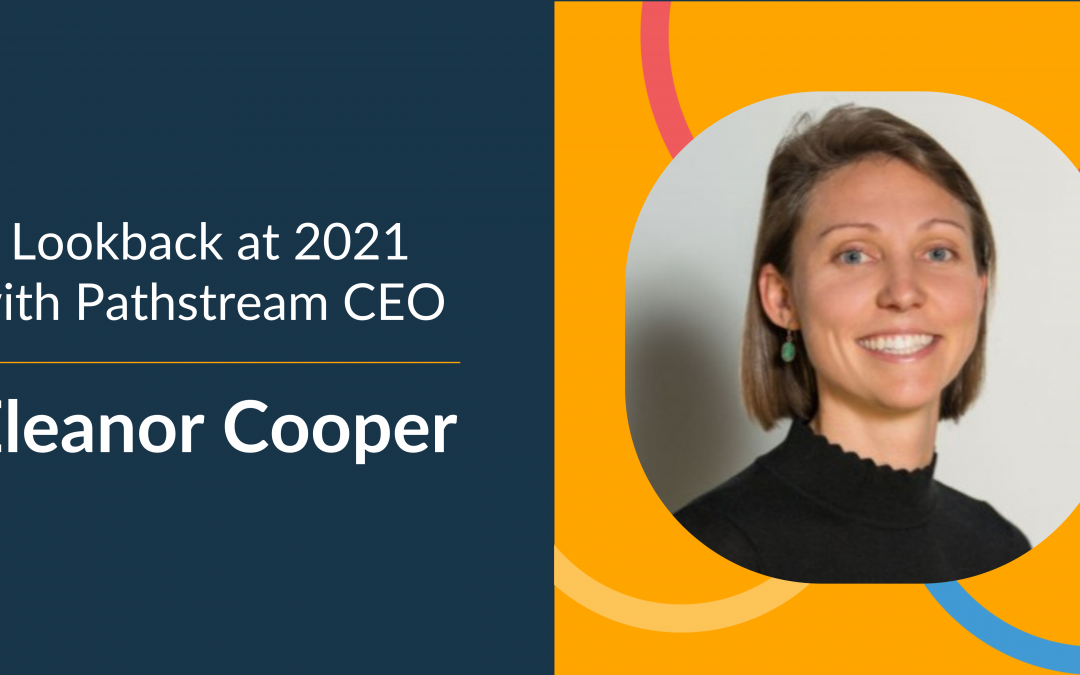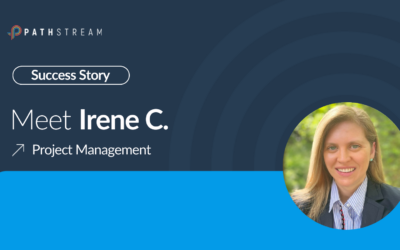2021 was the year we all adapted to a “new normal.” For Pathstream, 2021 was a year of significant growth as working adults grappled with pandemic conditions and remote workplaces, and employers faced retention challenges during the Great Recession.
Pathstream’s CEO Eleanor Cooper took the time to reflect on Pathstream’s 2021 accomplishments and to answer our questions about 2022:
What did Pathstream accomplish in 2021?
Pathstream saw enormous growth in 2021, both as a company and in who we serve. Our work became more relevant than ever with the accelerating speed of digital transformation, the need for affordable education alternatives as the college debt crisis deters enrollments and the urgent necessity for employer investment in talent management and retention.
Over 6,500 working adults enrolled in Pathstream programs last year and they had success at scale with over 80% career advancement success rate and an average salary increase of $17,000 for students that worked with our career services team. In addition to individuals, we served 150 new employers, including large cohorts of frontline employees at Amazon and Walmart. Through Pathstream programs, these employers were able to provide meaningful benefits to their employees, increase retention, and tangibly deliver on their DEI goals by supporting the career advancement of learners who are 71% non-white, 62% women, or non-binary, and 55% non-degree holders.
What from 2021 makes you the most proud?
In 2021, we solidified strategies to help people achieve their career goals and we saw our students achieve career advancement success at our highest rate yet. Nothing makes me more proud than hearing stories of aspiring adults accomplishing something they weren’t sure they could do. Students like Keilandra went from being a school bus driver to a data analyst within a few weeks of completing her certificate. Or Robert, who landed a promotion a few days after his final assignment. One of our most important roles is helping people understand that everything they need to succeed is within their reach–we provide the tools and path for them to get there.
What are you most excited to focus on in 2022?
We continue to self-reflect and learn so much from student feedback, instructor insights, our hiring partners, and our data. We used this information to create big goals for 2022 and to implement action-driven changes that improve the student experience.
For millions of American workers, the process of advancing their career is chaotic, seemingly arbitrary, and ultimately broken. The labor market is in flux. Many types of frontline work in traditional industries are less safe than ever before and offer fewer benefits than people want and need. They want “recession-proof” jobs that will help them feel more secure about providing for their families over the long term. In 2022, we will be focused on helping working adults make these career transitions without being held back by a daunting process or lack of support. This becomes increasingly important as the pandemic continues to accelerate the speed of automation and the use of technology by employers. In 2022 we want to focus on helping people navigate all stages of career advancement – from discovering what roles are the best next step, to confidence building through supported learning, to achieving outcomes that unlock the potential they had all along.
What are some of your predictions for 2022?
Employers struggled to attract and retain talent in 2021, and there is no sign of that stopping in 2022. We will see employers find new ways to compete for talent – the second most common reason for leaving a job, after compensation, is lack of career development opportunities, and 71% of employers now offer tuition assistance as a critical employee benefit. Investing in their education, supporting them to learn new skills and grow is one of the ways that employers deepen their relationship with their employees.
For a long time, hiring part-time employees, individuals with an employment gap, or those missing from the workforce by choice (hidden workers) was viewed as an act of corporate social responsibility. In reality, hiring only traditionally credentialed employees can limit employers’ ability to uncover new talent pools. This year, employers who are ready to think outside the box when it comes to talent acquisition will realize an attractive return on investment. In fact, “[they are] 36% less likely to face talent and skill shortages compared to companies that do not hire hidden workers.”
I look forward to partnering with employers to give them the insights and capabilities to tap into the potential of this new talent pool and to offer learning experiences that will strengthen employee retention and loyalty.
Latest News
Projecting Success: Irene’s Path from stay-at-home parent to Project Coordinator
Irene Carbonell is a shining example of personal growth and success. Irene has taken her career to new heights,...
Student Success Story: Finding financial freedom & work-life balance as a busy dad
Meet Brandon Smith: Project Manager at MRM Brandon Smith started working in a retail role years ago, where he...
From Senior Admin to Project Manager: Marcus Vega Eisenhart’s Success Story
A versatile Senior Admin at Walmart Marcus, a former Senior Admin at Walmart's bustling e-commerce facility, was the...
Was this helpful?
Thanks! What made it helpful?
How could we improve this post?









